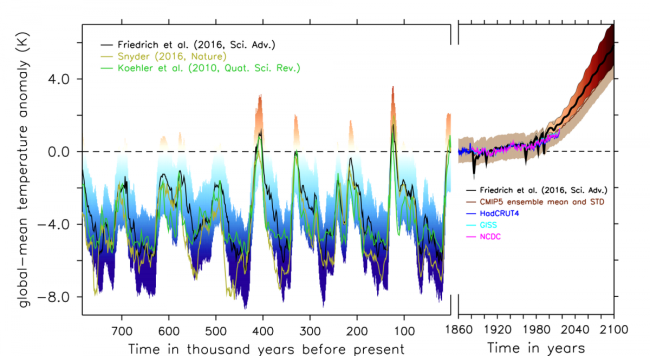Paleodata-based global warming projection provides independent confirmation of CMIP5 estimates
Projecting the magnitude of global warming that will occur in response to anthropogenic greenhouse gas (GHG) emissions is one of the most critical challenges of climate science. Besides human decision-making that will affect future atmospheric GHG concentrations, this magnitude is determined by Earth's climate sensitivity. The climate sensitivity is defined as the equilibrated change in global mean surface air temperature (SAT) for a given change in radiative forcing and has been a major focus of climate research over the last three decades.

A new research paper by Friedrich et al. looks at glacial-interglacial climate variability during the last 784,000 years to estimate Earth's climate variability. The team combined paleoproxy data of sea surface temperature with output from a transient model simulation to reconstruct global-mean SAT variability during the last eight glacial cycles. The second step involved calculating Earth’s energy balance for this time period, using estimates of GHG concentrations extracted from air bubbles in ice cores, and incorporating changes in Earth's orbit and ice sheet cover.
The results of the study imply that Earth's climate sensitivity is strongly dependent on the climate background state with significantly larger values attained during warm phases. This finding is of particular importance as Earth is currently in a warm - or interglacial - state and the associated increased climate sensitivity has to be taken into account for future warming projections.
Using the business-as-usual scenario for GHG radiative forcing (RCP8.5) and their novel estimate of Earth's warm-phase climate sensitivity the authors find that the resulting warming during the 21st century overlaps with the upper range of the Coupled Model Intercomparison Project Phase 5 (CMIP5) climate simulations. The global warming projected by the study for the year 2100 amounts to 5.86°C (likely range: 4.78-7.36°C) above preindustrial levels. Comparing this warming to the reconstructed global-mean SAT variability during the last eight glacial cycles, the study concludes that unabated GHG emissions are likely to push Earth's climate out of the envelope of temperature conditions that have prevailed for the last 784,000 years.
1University of Hawaii
2University of Washington
3University at Albany
4Potsdam Institute for Climate Impact Research, Germany
Topics
- Paleo
- Modeling
- Climate Change
